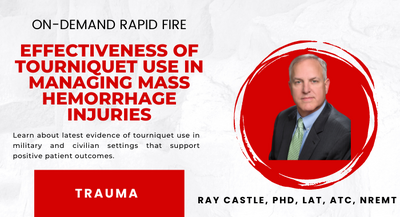Course Info (Description; Learning Objectives; Practice Gap; Clinical Bottom Line; Summary Conclusions)
Description:
The presentation titled "Effectiveness of Tourniquet Use in Managing Mass Hemorrhage Injuries" focuses on the use of tourniquets in the management of mass hemorrhage injuries of the extremities. This presentation will cover the pathophysiology of such injuries and the interventional outcomes using various types of commercial vs. improvised tourniquets. The presentation will also critically analyze and discuss current evidence-based studies involving positive clinical outcomes in using various types of tourniquets in modern military trauma. The types and limitations of various commercially available tourniquets utilized in both tactical and civilian pre-hospital trauma situations will be distinguished. Additionally, the presentation will analyze and discuss evidence-based decision-making criteria in the application of tourniquets for various limb trauma situations. Lastly, the presentation will use and apply knowledge of tourniquets to various pre-hospital trauma situations encountered by athletic trainers.
BOC Domains of Athletic Training:
-
Domain II - Clinical Evaluation and Diagnosis
-
Domain Ill - Immediate and Emergency Care
Upon completion of this course, participants will be able to:
-
Recognize the pathophysiology of mass hemorrhage injuries of the extremities, with a focus on interventional outcomes using various types of commercial vs. improvised tourniquets.
-
Critically analyze and discuss current evidence-based studies involving positive clinical outcomes in using various types of tourniquets in modern military trauma.
-
Distinguish the types and limitations of various commercially available tourniquets utilized in both tactical and civilian pre-hospital trauma situations.
-
Critically analyze and discuss evidence-based decision-making criteria in the application of tourniquets for various limb trauma situations.
-
Use and apply knowledge of tourniquets to various pre-hospital trauma situations encountered by athletic trainers.
Practice Gap:
Despite the effectiveness of tourniquets in managing mass hemorrhage injuries of the extremities, there is a gap in the knowledge and skills of healthcare providers, including athletic trainers, in their use and application. This gap is particularly notable in the recognition of the pathophysiology of mass hemorrhage injuries and the critical analysis and discussion of current evidence-based studies involving positive clinical outcomes in using various types of tourniquets. There is also a gap in understanding the types and limitations of various commercially available tourniquets utilized in both tactical and civilian pre-hospital trauma situations. This knowledge gap leads to a delay in the application of tourniquets, which could result in increased mortality and morbidity rates. Therefore, there is a need to bridge this gap in knowledge and skills among healthcare providers, particularly athletic trainers, in the effective use and application of tourniquets in managing mass hemorrhage injuries of the extremities.
Clinical Bottom Line:
Commercial tourniquets (e.g. Combat Application Tourniquet, or CAT; pneumatic tourniquets; et.) have consistently been demonstrated to be highly effective in the rapid early control of major bleeding. These devices are preferred over improvisational techniques in their demonstrated ability to provide arterial and venous ocCLusion, as well as minimal risk of palsy development at the tourniquet site. Commercial tourniquets (such as the Combat Application Tourniquet) are relatively inexpensive (less than $25) and can be easily carried in medical kits or in a person's pocket for easy accessibility. Additionally, and of practical importance, is the simplicity of use and greatly reduced learning curve to effectively and correctly apply the tourniquet. Commercial tourniquets are designed for a "one-size fits all". Of special note is that one limitation of tourniquets is the inability to stop bleeding above the upper thigh or upper arm.
Summary Conclusions:
- The management of pre-hospital trauma patient care skill sets should include the use of commercial tourniquets.
- The early use of tourniquets to stop bleeding in major limb trauma results in high survival rates in both military and civilian settings where blunt-force or penetrating trauma to the extremities has occurred.
- There is strong supporting evidence of a low morbidity risk of palsies at the site of tourniquet application.
- Not using or hesitating to apply a tourniquet to an extremity with major bleeding will result in an increased likelihood of mortality.
- Non-tourniquet methods (e.g., hemostatic agents, direct pressure, etc.) to stop major bleeding in extremity trauma are not effective interventions alone; however should be considered and utilized as part of the interventions in addition to tourniquet use.


